The knee is the most common body part that breaks down in runners, and when it does, it usually causes a temporary or permanent halt in one's running regimen. When injured, practising yoga can help you heal and avoid injury in future.
In fact, even if you do yoga only once a week, you'll notice a big difference in your running, says Alex Mazerolle, founder of Girlvana Yoga and the co-owner of Distrikt Movement in North Vancouver, Canada. Here, she demonstrates a five-pose circuit that takes just 15 minutes to complete.
"Doing this simple circuit two to three times a week would make a world of difference to your running," says 28-year-old Mazerolle, who is also a yoga teacher for the EA Sports app, Yogify.
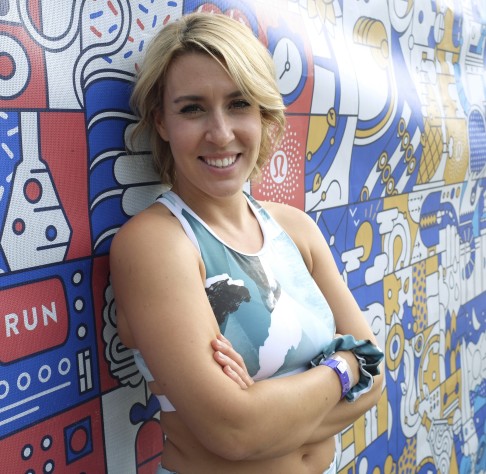 Alex Mazerolle is founder of Girlvana Yoga and the co-owner of Distrikt Movement in North Vancouver, Canada.
Alex Mazerolle is founder of Girlvana Yoga and the co-owner of Distrikt Movement in North Vancouver, Canada.
Mazerolle says runners in her yoga classes often have tight hamstrings, shoulders, and hips and glutes. The feet, lower legs, knees, thighs, hips, lower back, core, and arms are all part of a kinetic chain. When one link isn't working properly, the consequences can be felt up or down the chain - including the knee.
Christine Felstead, author of the book Yoga for Runners (2013), says runners are often reluctant to try yoga, but can gain tremendous benefits from adding yoga to their fitness regimen.
Yoga restores and improves body symmetry, alignment and balance, she says, and this prevents injuries from occurring while healing stubborn, chronic, and recurring ones. Yoga postures help align the knee joint while strengthening the arches of the feet for better shock absorption. This reduces the weight-bearing impact of running.
"Runners have a high threshold for dealing with pain and learn to live with aches and pains as part of daily living," Felstead says. "Runners are often amazed at how many of these nagging discomforts are eliminated with yoga practice."
Mazerolle says yoga also helps boost mental capacity, increasing focus and calming the mind, which is especially important in longer races such as the half- or full marathon. Yoga also teaches you how to breathe very deeply and encourages the expansion of the lungs.
"When running, you'll get more oxygen in the lungs," says Mazerolle.
She suggests performing the following circuit in the sequence shown after a run. Take five deep inhales/exhales - or more if you want - for each pose, unless indicated otherwise.
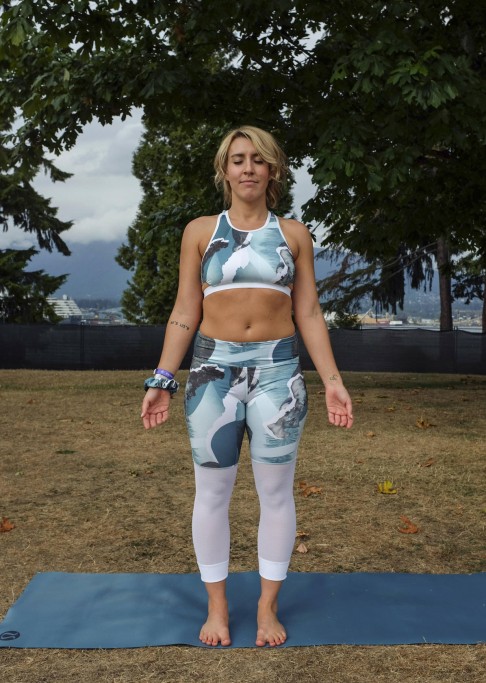 Mountain pose.
Mountain pose.
1. Mountain pose
Stand with feet a shoulder width apart, close your eyes and breathe. This pose encourages the right body alignment and puts you in an anatomically neutral position - an upright body with weight equally distributed on the feet and the head stacked over the shoulders. It's deceptively easy but runners with a knee problem usually have trouble standing perfectly aligned.]
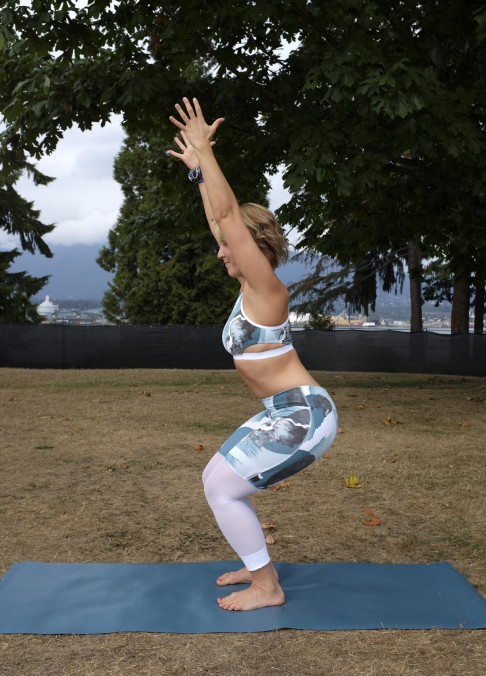 Chair pose
Chair pose
2. Chair pose
Stand in mountain pose with your feet together. On an inhale, sweep both arms up. On an exhale, bend your knees and sink into a high squat. Gaze ahead or up to your hands. If your knee injury is very bad, prop yourself up against a wall and/or remain in a high squat. Work on bending the knees in the same alignment. For sore or stiff upper back or shoulders, place your hands on your hips. The pose works the inner and outer thighs so that ligaments in the knee are equally strengthened. A lot of runners tend to be too strong in the IT band (outer thigh). The posture will also strengthen the quadriceps, hamstrings and glutes for running speed and power, and reinforce the foot and ankle muscles to aid absorption of impact when running. Sink lower to increase the intensity.
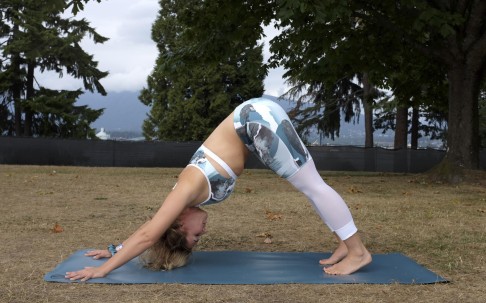 Downwards facing dog pose
Downwards facing dog pose
3. Downwards facing dog
Begin on all fours. Spread your fingers and slowly lift the hips up. The pose stretches out your hamstrings and calves, and builds upper body strength. A lot of people with knee problems have very tight hamstrings and calves, as well as stiff back and hips - this can cause your back to round when doing this pose, placing extra weight on your hands and shoulders. Try to keep your back flat.
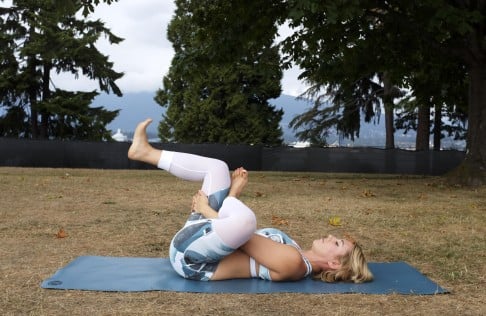 Thread the needle pose
Thread the needle pose
4. Thread the needle
Lie on your back with feet on the floor and knees bent. Cross your right leg to place your right ankle just above the left knee or thigh. Reach your hands under your left thigh and pull your left knee towards your chest. Ensure your back remains flat on the floor. This pose helps to open up the IT band, hips and glutes.
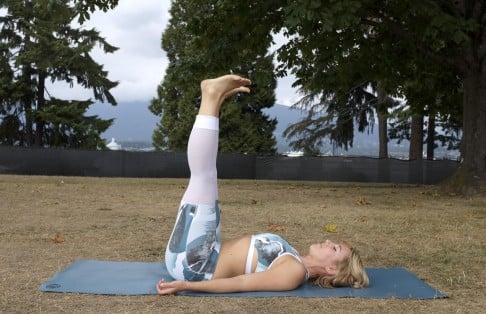 Legs up the wall pose
Legs up the wall pose
5. Legs up the wall
If you don't have a wall around, just elevate your legs in mid air above the pelvis. Hold the pose for three to five minutes. This encourages blood flow down from the feet, alleviating swelling in the ankles and knees. It also promotes relaxation and sleep.
 Alex Mazerolle is founder of Girlvana Yoga and the co-owner of Distrikt Movement in North Vancouver, Canada.
Alex Mazerolle is founder of Girlvana Yoga and the co-owner of Distrikt Movement in North Vancouver, Canada. Mountain pose.
Mountain pose. Chair pose
Chair pose Downwards facing dog pose
Downwards facing dog pose Thread the needle pose
Thread the needle pose Legs up the wall pose
Legs up the wall pose
